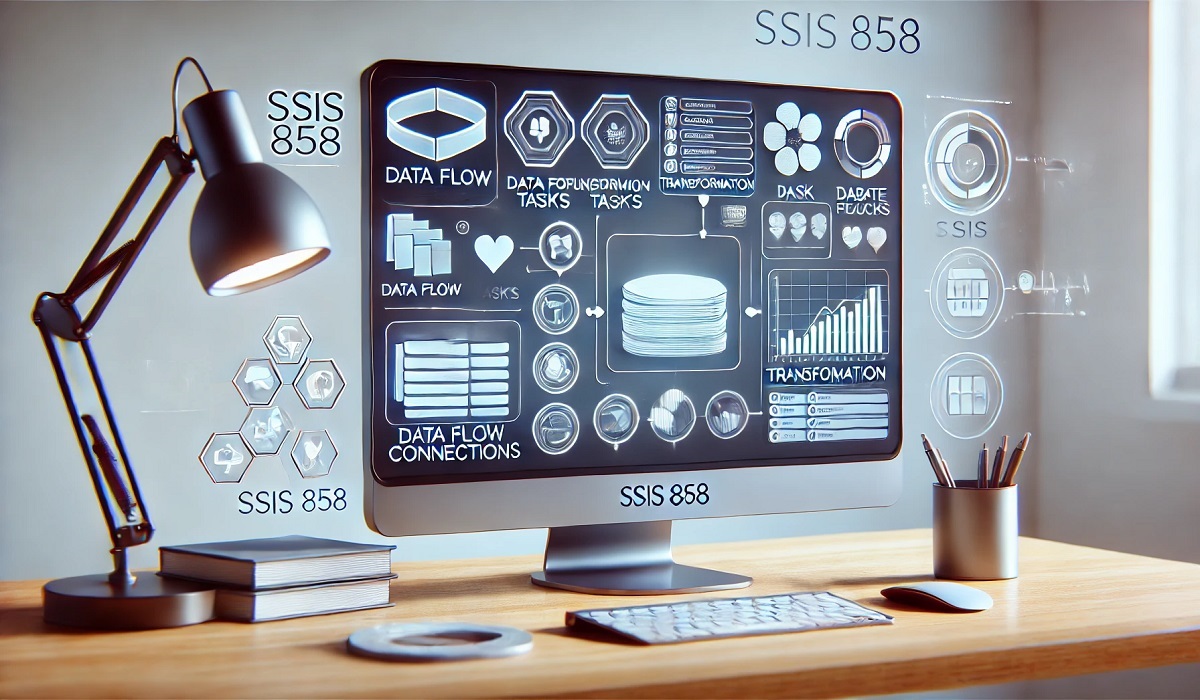TECHNOLOGY
SSIS 858: Everything You Need to Know

In the world of data integration and management, SSIS 858 plays an essential role. Whether you’re handling large datasets or working with multiple systems, SSIS (SQL Server Integration Services) provides a robust platform for moving, transforming, and managing data. SSIS 858, a particular version or build, is often associated with specific features, tools, and enhancements that make it an important part of any data integration pipeline. In this article, we’ll delve into the specifics of SSIS 858, exploring its capabilities, installation, use cases, and the advantages it brings to your data workflows.
What is SSIS 858?
SSIS 858 refers to a version or release of SQL Server Integration Services (SSIS), a component of Microsoft SQL Server. SSIS is a platform used for building data integration and data transformation solutions. It helps in the extraction, transformation, and loading (ETL) of data across different databases and systems.
While SSIS 858 might not be as commonly discussed as the latest versions of SSIS, it plays an important role in certain enterprises and systems. Typically, SSIS 858 is noted for specific functionalities such as enhanced data flow, increased scalability, or extended compatibility with other Microsoft technologies.
Key Features of SSIS 858
One of the primary reasons for the widespread use of SSIS 858 is its feature-rich environment that can tackle various data integration challenges. Here are some of the key features of this version:
- Advanced-Data Transformation:
SSIS 858 offers enhanced capabilities for transforming data, making it easier to manipulate and convert data formats during the ETL process. Complex transformations can be carried out with ease, whether dealing with text files, databases, or XML data. - High Performance and Scalability:
One of the standout features of SSIS 858 is its ability to handle large volumes of data. With improved performance capabilities, SSIS 858 ensures faster processing of data flows and increases the overall efficiency of your data integration tasks. - Error Handling and Debugging Tools:
SSIS 858 offers robust error handling and debugging tools, which help users identify issues quickly during data integration processes. The platform allows users to trace and log errors, offering more transparency into data transformations. - Connectivity with Multiple Data Sources:
With SSIS 858, you can connect to a wide variety of data sources, including SQL Server databases, Oracle databases, flat files, Excel files, and even web services. This flexibility allows for seamless integration across various platforms. - Improved Control Flow:
SSIS 858 also features improved control flow, which lets users automate and manage the sequence of tasks in their data integration jobs. It allows for tasks to be conditionally executed and provides a visual interface for easy workflow management. - Support for Data Warehousing:
For businesses implementing data warehousing solutions, SSIS 858 offers support for populating data warehouses with clean, transformed data. This capability is critical for analytics and reporting, as it ensures that data is ready for business intelligence tools.
Benefits of SSIS 858
The advantages of using SSIS 858 go beyond its technical features. Here are some of the core benefits that this version brings to the table:
- Efficiency in Data Movement:
SSIS 858 speeds up data transfer and transformation, making it possible to handle high-volume data integrations without compromising on performance. - Cost Savings:
As an integrated part of the SQL Server suite, SSIS 858 can help organizations reduce the cost of managing third-party data integration tools. Because it is already part of the Microsoft ecosystem, the setup and maintenance costs are generally lower. - Flexibility in Integration:
SSIS 858’s compatibility with numerous data sources allows for flexibility when integrating disparate data systems. Whether you are working with relational databases, cloud services, or flat files, SSIS 858 can handle the integration without any significant issues. - Automated Data Flow:
Through its control flow management, SSIS 858 automates the entire ETL process. This automation reduces the need for manual intervention and ensures that data integration tasks are handled more reliably and consistently. - Increased Data Quality:
By providing tools for error handling, data cleansing, and transformation, SSIS 858 ensures that the data integrated into your system is of high quality. Clean and transformed data means better insights and decision-making in your organization.
How to Install SSIS 858
Installing SSIS 858 involves a series of steps to ensure proper configuration and setup. Here’s a brief overview of the installation process:
- System Requirements:
Before installing SSIS 858, make sure your system meets the following requirements:- SQL Server 2012 or later.
- .NET Framework 4.0 or later.
- Sufficient disk space and memory for data processing.
- Download and Installation:
- Step 1: Download the version of SQL Server that includes SSIS 858. You can find the installer on the official Microsoft website or through your SQL Server management console.
- Step 2: Run the installer and follow the on-screen instructions. Choose the installation of SQL Server Integration Services during the SQL Server setup process.
- Step 3: Once installed, configure the SSIS components as needed. Ensure the SSIS services are properly enabled and start running.
- Configuration:
After installation, you can configure SSIS 858 using SQL Server Data Tools (SSDT), which provides a visual interface for managing SSIS packages and workflows. Set up your data sources and configure connection managers to begin integrating your data. - Testing:
Run sample ETL packages to test that everything is working correctly. Ensure that data is being pulled from the source, transformed as expected, and loaded into the destination system.
Common Use Cases for SSIS 858
SSIS 858 is ideal for businesses and enterprises looking to streamline their data integration processes. Some common use cases include:
- Data Warehousing:
Businesses use SSIS 858 to populate data warehouses with clean, transformed data. This process is essential for analytical and reporting tasks, helping companies gain valuable insights into their operations. - ETL Jobs:
SSIS 858 is widely used for creating and automating ETL jobs, which extract data from various sources, transform it according to business rules, and load it into a target system for further processing. - Data Migration:
When moving data from one platform to another, SSIS 858 is often employed to ensure that data is transferred seamlessly while maintaining data integrity and quality. - Automating Data Integration:
Many companies automate data integration tasks using SSIS 858. By setting up workflows and triggers, SSIS 858 helps businesses maintain real-time data synchronization across systems. - Legacy System Integration:
In cases where businesses need to connect legacy systems with modern databases, SSIS 858 can be configured to bridge the gap and enable smooth data flow between old and new technologies.
Is SSIS 858 Suitable for Your Organization?
Determining if SSIS 858 is the right solution for your organization depends on your specific needs and requirements. Here are some factors to consider:
- Volume of Data:
If your organization handles large volumes of data that need to be integrated across multiple systems, SSIS 858 is likely a good fit due to its scalability and performance. - Data Complexity:
For businesses that require complex data transformations, SSIS 858’s advanced transformation features can help you clean and prepare your data more effectively. - Integration with Microsoft Products:
If you are already using other Microsoft products (such as SQL Server, Azure, or Office 365), SSIS 858 integrates seamlessly with these tools, providing a cohesive data integration experience. - Budget:
If cost is a concern, SSIS 858 provides a cost-effective data integration solution as it is included with SQL Server and does not require the purchase of additional software licenses.
Conclusion
SSIS 858 plays a critical role in modern data integration, providing businesses with the tools they need to move, transform, and manage data across systems. With its robust features, flexibility, and high performance, it is an essential tool for companies that need reliable and scalable data integration solutions. Whether you’re working with large datasets, migrating data between systems, or automating data workflows, SSIS 858 provides the tools and capabilities to handle complex data integration tasks with ease.
If you are looking for a powerful, cost-effective solution for your data management needs, SSIS 858 is certainly worth considering. By leveraging its advanced features and integration with Microsoft technologies, you can optimize your data processes and ensure smoother, more efficient workflows.
FAQs
What is SSIS 858?
SSIS 858 is a version of SQL Server Integration Services (SSIS), a platform used to integrate, transform, and move data across systems.
What are the key features of SSIS 858?
SSIS 858 offers advanced data transformation, high scalability, error-handling tools, and support for a wide range of data sources.
How do I install SSIS 858?
Install SSIS 858 by downloading SQL Server and selecting the SSIS component during installation. Configuration is done via SQL Server Data Tools (SSDT).
What are the common use cases for SSIS 858?
Common use cases include data warehousing, ETL jobs, data migration, and automating data integration tasks.
Is SSIS 858 suitable for large enterprises?
Yes, SSIS 858 is designed to handle large volumes of data and is highly scalable, making it suitable for enterprises with complex data integration needs.

 BUSINESS8 months ago
BUSINESS8 months agoService Top: Understanding Role, Dynamics, and Consent in Relationships

 GUIDE6 months ago
GUIDE6 months agoLookmovie2.to Legit: A Detailed Review of Safety and Features

 FASHION7 months ago
FASHION7 months agoDIY Tips to Customize Your Orange Prom Dress and Stand Out

 GUIDE6 months ago
GUIDE6 months agoTokybook: Your Gateway to the World of Audiobooks

 TECHNOLOGY7 months ago
TECHNOLOGY7 months agoUnderstanding Libgen: The Ultimate Free Ebook Library

 GUIDE8 months ago
GUIDE8 months agoLeague of Graphs: The Ultimate Guide to League of Legends Stats and Analysis

 GUIDE7 months ago
GUIDE7 months agoLook at All Those Chickens: The Story Behind the Viral Meme

 FASHION6 months ago
FASHION6 months agoClerical Collar: History, Significance, and Modern Use
















